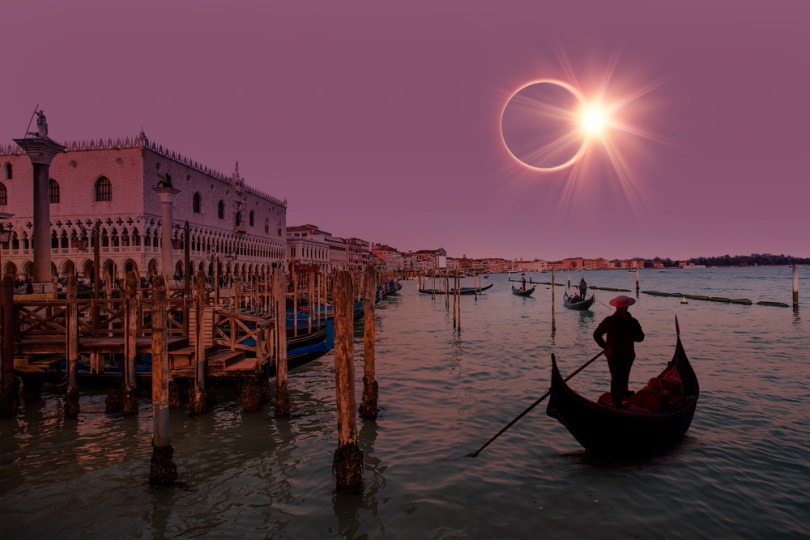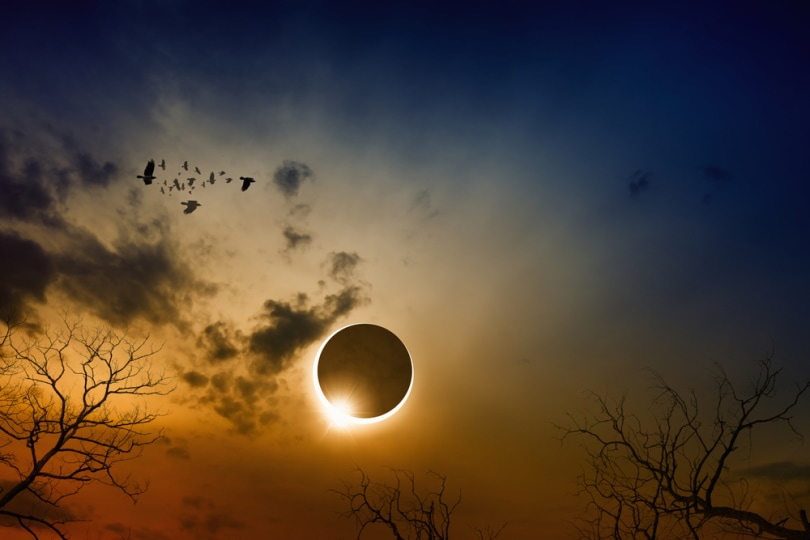11 Interesting Facts About Solar Eclipses You Never Knew (2024 Updates)
Last Updated on

A solar eclipse can be a fun thing to experience because it happens during the day, so even if you don’t have any equipment to look safely at the sun, you still get to be a part of it. In ancient times, people would get afraid when an eclipse occurred and worry that the gods had something in store for them. Nowadays, viewing one can make a great science project for people of all ages. So, keep reading as we look at 11 interesting facts about solar eclipses that should help get you excited about the next event in your area.

Top 11 Facts About Solar Eclipses
1. There are between two and five solar eclipses every year
Though they seem quite rare, between two and five solar eclipses happen every year. Not all are visible from the same location, however, and many are only partial eclipses that don’t get the same media attention, so we don’t hear about them as often. We are also less likely to notice any environmental changes during a partial eclipse, so we might not even know when one occurs, especially if you work indoors.

2. A total eclipse occurs every 18 months
A total eclipse is a dramatic event that only occurs once every 18 months. This is when the moon’s path takes it directly in front of the sun and blocks it out completely. The sky will get as dark as night for several minutes until the continuing movement of the moon moves it out of the way so the sunlight can return.
3. A total eclipse can last more than 7 minutes
The longest recorded solar eclipse occurred on June 20, 1955, and lasted for 7 minutes and 7 seconds. However, most eclipses are short, like the one on July 20, 2009, which lasted 6 minutes and 39 seconds. Some eclipses can be even shorter than that. It all depends on where the moon is in relation to the Earth and the sun at the time of the eclipse.

4. An identical eclipse occurs every 18 years and 11 days
The Earth and the moon follow an extremely predictable path that repeats every 18 years and 11 days, at which time, you will see the same eclipse occur in the same places. This repeating pattern is the Saros Cycle, and we have known about it for thousands of years.
5. Solar eclipses are predictable
The Saros Cycle is a repeating pattern every 18 years and 11 days. This cycle enables us to accurately predict eclipses worldwide well in advance.

6. The weather can change dramatically during a solar eclipse
Since a solar eclipse prevents sunlight from reaching the surface of Earth, the temperature can drop dramatically. In some cases, the temperature dropped by as much as 39 degrees Fahrenheit. People also notice an increase in wind and clouds during the eclipse, which can have wide-reaching effects on the environment.
7. The sun is 400 times larger than the moon, but it’s covered completely during an eclipse
It’s quite amazing that the moon can completely cover the sun during an eclipse despite being 400 times smaller. If the moon were any farther away from the Earth, like the moons of other planets, we would never experience a total eclipse because the moon couldn’t cover the sun completely.

8. Solar eclipses won’t occur forever
Scientists have learned that the moon is slowly drifting away from Earth. Once it gets too far out, it will no longer be able to completely cover the sun during a total eclipse. The phenomena will cease to exist, replaced by what is now called an annular eclipse, which is when a ring of sunlight is visible around the moon.
9. The shadow of a solar eclipse can travel at more than 3,000 mph
As the moon moves between the sun and the Earth, it creates a shadow that travels at more than 3,000 mph across the surface of the Earth. This shadow speed combines the Earth’s rotation and the moon moving at 1,398 mph.

10. It’s possible to go blind watching an eclipse without protection
Unfortunately, if you look at the sun too long during an eclipse, it can cause serious eye damage and you can even go blind. Obtaining the proper safety equipment before viewing an eclipse is essential to your health. Always wear eye protection, or use a method that enables you to view the eclipse using reflections on paper.
11. It’s possible to see planets and constellations during an eclipse
When the sky becomes dark during an eclipse, it’s possible to see constellations and even planets as if it were nighttime. In fact, doing so will let you see into the future because the constellation that you see won’t be visible in the night sky for several months.

How can I safely view a solar eclipse?
For most people, the easiest way to view a solar eclipse safely is to use ISO-certified eclipse glasses. You can purchase these glasses online, and they are as easy to use as an ordinary pair of sunglasses. However, these are for unassisted viewing only, and you should never use them to look through a telescope or camera. These glasses filter out the bright light and harmful ultraviolet light to help protect your eyes while watching the eclipse. If you want to use binoculars or a telescope to look at the sun, we recommend using solar filters to protect your eyesight. You can also use a pinhole projector to view the eclipse without looking at the sun for the best protection.

How do I know when a solar eclipse will occur?
A solar eclipse is a big event, so it will likely be broadcast on the news before it occurs, especially if you live in an area with good visibility. If you prefer to find out ahead of time, you can check several online sources to know when the eclipse will occur and where the best visibility will be.

Conclusion
Solar eclipses are fascinating, and fortunately, there are ways that you can view them safely. Since they are highly predictable, you can find out when one will happen so you can get your supplies ready and make travel plans. Unfortunately, total eclipses are only viewable along narrow paths. It can be difficult to find one if you don’t use a special map, but it will likely leave a lifelong memory if you do get to experience it.
Featured Image Credit: muratart, Shutterstock
Table of Contents
- Top 11 Facts About Solar Eclipses
- 1. There are between two and five solar eclipses every year
- 2. A total eclipse occurs every 18 months
- 3. A total eclipse can last more than 7 minutes
- 4. An identical eclipse occurs every 18 years and 11 days
- 5. Solar eclipses are predictable
- 6. The weather can change dramatically during a solar eclipse
- 7. The sun is 400 times larger than the moon, but it’s covered completely during an eclipse
- 8. Solar eclipses won’t occur forever
- 9. The shadow of a solar eclipse can travel at more than 3,000 mph
- 10. It’s possible to go blind watching an eclipse without protection
- 11. It’s possible to see planets and constellations during an eclipse
- How can I safely view a solar eclipse?
- How do I know when a solar eclipse will occur?
- Conclusion
About the Author Ed Malaker
Ed Malaker is a veteran writer who contributes to a wide range of blogs covering information on computer programming, pets, birding, tools, fitness, guitars, and optics. Outside of writing, Ed is often found working in the garden or performing DIY projects in the house. Ed is also a musician, spending his time composing music for independent films or helping people repair their guitars.
Related Articles:
15 Crucial Facts About Ultraviolet Rays & the Sun
What Constellation Is Spica In? The Interesting Answer!
10 Interesting Leo Constellation Facts, Myths, and FAQs
15 Interesting Pegasus Constellation Facts, Myths, and FAQs
6 Interesting Sagittarius Constellation Facts, Myths, and FAQs in 2024!
What Are Constellations? Where Did They Come From?
8 Interesting Libra Constellation Facts, Myths, and FAQs
What Is Infrared Radiation? Science-Based Facts & FAQ
